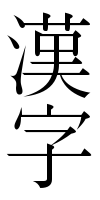Kanji facts for kids
Kanji (漢字) is one of the three main ways to write in Japanese. Think of a kanji as a special kind of picture symbol. These symbols are designed to show the meaning of a word. It's like a small drawing that represents an idea, an object, or a quality.
Kanji symbols were originally taken from Chinese characters. Over a long time, many of them changed a bit. The word "kanji" itself means "Han characters," which is another way of saying "Chinese characters."
Contents
Kanji and Kana: What's the Difference?
Besides kanji, there are two other systems used to write in Japanese. These are called hiragana and katakana. Together, they are known as "kana." Kana characters are different from kanji because they show how a word sounds. Each kana character stands for a syllable, like "a," "ka," "sa," or "ta."
You could write almost any kanji word using kana. In fact, children's books or books for people from other countries learning Japanese often show kanji words written in kana too.
Japanese has many words that sound exactly the same but have different meanings. These are called homophones. For example, the sound kami can mean "god," "hair," "paper," or "upper stream." If you write these words using only kana, they would all look the same (かみ in hiragana or カミ in katakana). But because they have very different meanings, each word uses a different kanji symbol. For "god," the kanji is 神. For "hair," it's 髪. For "paper," it's 紙. And for "upper stream," it's 上.
However, it can get a bit tricky! Each kanji symbol can also have several different pronunciations. The pronunciation depends on which meaning of the word is intended.
Kanji symbols were first created to look like what they mean. For example, the Japanese symbol for "mouth" is 口 (pronounced kuchi), and it looks a bit like a mouth. Another word, 山 (pronounced yama), means "mountain." Japanese has many words that can be shown with just one kanji. Sometimes, two kanji symbols are put together to make new words. For instance, 山口 (yamaguchi) combines "mountain" and "mouth" to mean a cave. This combination is also a family name and the name of a prefecture (a region in Japan).
Kanji is often used with hiragana. The hiragana parts help show the grammatical meaning of the word. In English, we do this with word endings. For example, "act" (the verb) and "action" (the noun) are related but have different endings.
How Kanji Are Read: Kun-yomi and On-yomi
Most kanji symbols can be pronounced in at least two different ways. One way is called the "kun" reading, or "kun-yomi." This is used for words that are originally Japanese. The other way is called the "on" reading, or "on-yomi." This reading comes from how the word was pronounced in Chinese when it was borrowed.
When a kanji stands alone, it usually uses its kun-yomi. But when kanji are combined to make compound words (words made of two or more kanji), they usually use their on-yomi.
Let's look at an example:
- The kanji 山 on its own means "mountain" and is pronounced "yama" (its kun-yomi).
- But when it's combined with another word or name, like in "Fuji-san" (Mount Fuji), it's pronounced "san" (its on-yomi).
Of course, there are many exceptions to these rules! For example, some native Japanese words with two or more kanji (especially proper names) still use their kun-yomi. An example is 山口, which is pronounced "yama-guchi," even though the on-yomi for those kanji would be "san" and "kō."
Sometimes, a kanji only has an on-yomi and no kun-yomi. For instance, the kanji 毒, which means "poison," is only pronounced "doku."
Sometimes, compound words mix both on-yomi and kun-yomi. For example, the word 金色, meaning "golden," is pronounced "kin-iro." Here, the first kanji uses its on-yomi ("kin"), and the second kanji uses its kun-yomi ("iro").
There are even some words where the kanji are used only to show the word's meaning, not its pronunciation. For example, the word 煙草 is pronounced "tabako," which means "tobacco." This word came from Portuguese. The pronunciation doesn't match the kanji readings, but the kanji mean "smoke" and "grass," which gives a hint about the word's meaning.
Finally, some words use kanji only to show their pronunciation, not their meaning. These are called ateji. For example, 亜米利加 is pronounced "Amerika," but the meanings of these kanji don't have a clear connection to America. Today, words like "America" are usually written only in katakana. However, some words like "sushi" are still sometimes written in ateji, like 寿司. This is because Chinese tourists might recognize the ateji more easily, as the word is written the same way in Chinese.
How Many Kanji Are There?
Kanji symbols are grouped by how many brush strokes it takes to write them. The simplest kanji have just one stroke, while the most complex can have up to 30 strokes!
There are many, many different kanji. The exact number isn't known, but it's thought to be around 50,000. Don't worry, not all 50,000 are taught in schools! The Japanese government has created a list of 1,945 basic kanji called the Jōyō Kanji. These are the ones people learning Japanese are expected to know. They are the most common kanji used in newspapers, magazines, street signs, and store signs.
Learning kanji takes many years. By the time a student finishes school, they should know about 1,850 kanji. A university graduate might know around 3,000. If someone doesn't know the kanji for a word, they can write it in kana, and it will still be understood. However, using kanji is usually the proper way to write it.
- New Japanese-English Character Dictionary ed J Halpern Kenkyusha 1990
Images for kids
-
The Nihon Shoki (written in 720 AD) is an important historical record of ancient Japan. It was written completely in kanji.
See also
 In Spanish: Kanji para niños
In Spanish: Kanji para niños






